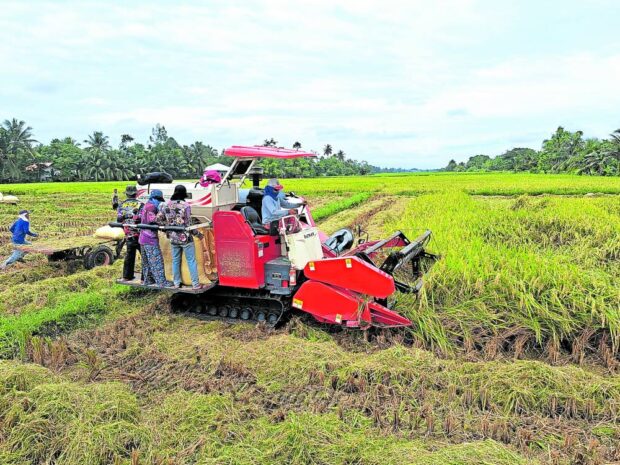In South Cotabato, gov sees rice sold at P30/kilo

HARVEST Farmers in the village of Dajay in Surallah, South Cotabato, harvest palay on Friday from farms under the consolidated rice production programof the provincial government. —BONG S. SARMIENTO
SURALLAH, SOUTH COTABATO—The rice-producing province of South Cotabato is on its way to achieving an average yield of 8 metric tons per hectare of palay (unhusked rice), farmers and government officials said on Friday.
“Based on the crop cut estimates, the yield is between a high of 12 tons and a low of 10 tons,” Gov. Reynaldo Tamayo Jr. said in Filipino during the Consolidated Rice Production and Mechanization Program (CRPMP) Farmers’ Field Day and Harvest Festival here.
A crop cut estimate is done through sampling a square meter of harvestable palay for every hectare of farmland.
Last June, Tamayo told a visiting President Marcos that the province could produce 8 MT of palay per hectare, double the national average.
Tamayo said the different farms chosen for crop cut yielded at least a kilogram of palay per square meter. There are 210 ha of contiguous palay farms in this town in different stages of maturity under the CRPMP that seeks to achieve compact rice farming which, in turn, ensures economies of scale.
Article continues after this advertisementAcross the province, some 1,600 ha of palay farms have already been consolidated, out of the 3,000-ha target, Tamayo said.
Article continues after this advertisementGiven the projected bumper harvest for the current cropping cycle, Tamayo said the price of ordinary milled rice “could be sold at P30 per kilo and could be further brought down to P25 per kilo in the next harvest period.”
“Our target really is to increase the income of farmers to encourage them to continue planting and produce more so that we can lower the price of rice for the consumers,” the governor said.
Tamayo noted that the province, with its 8 MT per hectare palay production, could be instrumental in helping bring down the price of rice to a level affordable to most Filipinos that, according to him, was the “dream” of the President.
Fake news?
Early this month, Mr. Marcos imposed a price cap on rice at P41 and P45 per kilo for regular and well-milled rice, respectively, after retail prices breached the P50 per kilo level.
The issue has been high on the public’s interest given the much touted goal of the administration to bring down the price of rice crop to only P20 per kilo, consistent with Mr. Marcos’ campaign promise.
Such a vow has been widely reported by various news organizations following then-presidential candidate Marcos in the campaign trail.
But Tamayo, president of Partido Federal ng Pilipinas, the political party of the President, has brushed these aside as “fake news” in a press conference following the speeches at the harvest festival.
But he expressed hope that the palay farming program of the province would be replicated in other parts of the country to help achieve rice self-sufficiency and contribute to bringing down rice prices.
If the target of consolidating 3,000 ha of palay farms will be achieved, Tamayo said the yield would be enough to feed South Cotabato’s population of about a million for 10 months.
He conceded though that there are “players,” apparently referring to rice cartels, who could spoil the target.
Henry Eslabon, chair of the Upper Valley Agriculture Cooperative, attested that a yield of 8 MT of palay per hectare was attainable.
“I have proven it myself in the past two years after I used hybrid seeds. The target of 8 MT per hectare, on average, is achievable. I’ve had excellent yields because the climate and soil here are suitable for the hybrid variety,” Eslabon told the Inquirer.
He added that he harvested such a volume of palay for six consecutive cropping seasons already.
Hybrid seeds
Using hybrid rather than inbred seeds is costly, but the former gives a much better income, Eslabon, a former municipal councilor here, said.
Under the consolidated rice program here, farmers planted the Arize Bigante Plus, a product of Bayer.
Hybrid palay seed costs P5,000 per sack, while the inbred variety sells for only P1,600, Eslabon said.
Hybrid seeds cannot be replanted, unlike inbred, though the latter’s yield volume drops the more these are replanted.
Eslabon noted that the government subsidy for the program—such as seeds, fertilizers, pesticides, and land preparation, among others—was a big help to farmer-beneficiaries, whose equity, in the form of labor, was 30 percent of the total production cost.
Loel Nillos, Surralah municipal agriculture officer, told the Inquirer that the prevailing farm gate price of palay here ranged from P19 to P19.50 per kilo.
He said that a farmer was able to harvest 146 sacks of palay at an average weight of 63 kilos a sack, from a hectare of land.
That’s about P175,000 for a production cost of P50,000, or a net income of P125,000, Nillos added.
“This only proves that a farmer can produce double the average production,” he said.
Nillos said the program would run for three years or six cropping cycles.